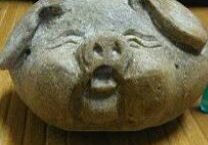
The Pig Garden
Pigs are incredibly smart animals, and their high level of intelligence consistently ranks them as one of the smartest animals in the world. Research into their high cognitive ability shows that they can play complex games, use tools, recognize their own name, and learn basic commands and tricks.
That's why we decided to dedicate a whole garden filled with pig statues to add character, fun and the love for the animals into our pig garden.

History of pigs
Pigs have been domesticated for thousands of years, with evidence of their existence dating back to around 5000 BC. They were first domesticated in the Near East and quickly spread to other regions of the world. Pigs were an important source of food for many ancient cultures, providing meat, fat, and hides. In the Middle Ages, pigs were commonly kept in towns and villages for their ability to eat waste and garbage, making them valuable "scavengers." Today, pigs are raised for their meat in large-scale commercial farming operations around the world.
5000 BC
Domestication of pigs
The domestication of pigs dates back to around 5000 BC in various regions such as China, India, and the Middle East. These early domesticated pigs were used for their meat and other resources, and became an important source of food for many ancient civilizations.


1493
Pigs introduced to the Americas
Pigs were brought to the Americas by Christopher Columbus during his second voyage in 1493. These pigs quickly multiplied and spread throughout the continent, becoming an important source of food for the indigenous peoples and European settlers.
18th century
Selective breeding of pigs
In the 18th century, selective breeding of pigs became more common, leading to the development of specific breeds with desired traits such as size, color, and meat quality. This marked the beginning of modern pig farming practices.


1940s
Industrialization of pig farming
The 1940s saw the industrialization of pig farming with the introduction of intensive confinement systems and the use of antibiotics and growth hormones to enhance production. This shift towards large-scale, factory-style farming has had a significant impact on the pig industry.
Present
Modern pig farming practices
Today, pigs are one of the most important livestock animals in the world, with over 1 billion pigs raised for meat production annually. Modern pig farming practices continue to evolve, with a focus on animal welfare, sustainability, and efficiency in production.


Pigs as a Lucky Symbol
Many people associate pigs with being unclean, but it is a fact that the pig is a lucky symbol in many cultures. As this is a site about good luck symbols, our focus will be more on the positive symbolism of the pig.
The pig is a symbol of prosperity, fertility and lots of good luck. Swine farmers were known to always have food. Keeping pigs was a sure way of insuring your family’s well-being.
Western symbolism
- As the old Irish saying goes; “The pig is the gentleman who pays the rent”.
- In Germany they say “Glücksschwein”, which translates to lucky pig.
- Pig decorations and illustrations on good luck and best wishes cards are common in Germany. This is especially true around New Year.
- Candy in shapes of pigs symbolizes wishes of prosperity and luck. Marzipan pigs are sold in the thousands every December in Northern Europe.
- In Norwegian the term “heldiggris” is very common. It literally translates to “lucky pig”.
- The term is purely positive manner meaning “Wow, you are lucky”. In Swedish it is “tur gris” and in Danish it is “heldig gris”. In Iceland they say “heppinn svín”.


Pigs as a Wealth Symbol
We might know the Piggybank money symbol.
Pigs are associated with wealth. Many wear small pig charms to attract money and good luck.
Pigs have a history of insuring a family’s finances. Pig charms remain popular to this day. The piggybank is a worldwide symbol of money. Feeding our piggybank with coins is an undisputable sign that we are caring for our financial future.
Piggybanks are thought to protect and attract money.
Asian Culture
Feng Shui Pig -- Pigs are a symbol of wealth and good luck in traditional Chinese culture. They can attract wealth and success, improve interpersonal relationships and bring good luck.
The Pig in the Chinese Zodiac
The pig was the final animal to arrive to the feast of the Jade Emperor and thereby secured a place in the zodiac.
Each year is connected to an element; wood, fire, earth, metal and water.
In very general terms the pig is told to be sociable, popular, passionate and reliable. They may be quick tempered. It is a Yin sign.


The year of the pig comes every twelve years:
Pig Year Chinese Zodiac
Feb 4, 1935 – Jan 23, 1936 (wood)
Jan 22, 1947 – Feb 9, 1948 (fire)
Feb 8, 1959 – Jan 27, 1960 (earth)
Jan 27, 1971 – Feb 14, 1972 (metal)
Feb 13, 1983 – Feb 1, 1984 (water)
Jan 31, 1995 – Feb 18, 1996 (wood)
Feb 18, 2007 – Feb 6, 2008 (fire)
Feb 5, 2019 – Jan 24, 2020 (earth)
Jan 23, 2031 – Feb 10, 2032 (metal)
Feb 10, 2043 – Jan 29, 2044 (water)

Lord Vishnu as a Boar
Vishnu, the Hindu god of protection and preservation has ten well known avatars.
They are as follows; Matsya, the Fish – Kurma, the turtle – Varaha, the boar – Narasimha, the man-lion – Vamana, the dwarf – Parsuram –Lord Rama – Lord Krishna – The Buddha and finally he will be reincarnated as the Kalki (believers are still waiting for this to happen).
Vishnu Varaha Boar
In his third reincarnation Vishnu was the boar who came on a very important mission. An evil demon named Hiranyaksha had pulled Mother Earth to the bottom of the ocean. Vishnu, as the boar Varaha came to the rescue. After a long and fierce fight with Hiranyaksha he killed the demon. Varaha (Lord Vishnu) then lifted the Earth up from the ocean and back in place. The Earth was saved and life could continue.
Pig qUOTES
“I am fond of pigs. Dogs look up to us. Cats look down on us. Pigs treat us as equals.
“Believe each day that has dawned is your last. Some hours to which you have not been looking forward will prove lovely. As for me, if you want a good laugh, you will come and find me fat and sleek, in excellent condition, one of Epicurus’s herds of pigs.”
"I've always loved pigs: the shape of them, the look of them and the fact that they are so intelligent."
“I learned long ago, never to wrestle with a pig, you get dirty; and besides, the pig likes it.”
"I know", thought the pig. "I shall become an EXTRAORDINARY pig. I shall see the BEST in EVERYONE and EVERYTHING. I shall become THE PIG of HAPPINESS!"
"I love pigs. I think they're very cute. I really want a pet pig, but those micro pigs, they don't stay micro."
"A pig painted gold is still a pig."
An’ taking home a “load” with manly pride;
My poor feet began to stutter, so I lay down in the gutter,
And a pig came up an’ lay down by my side;
Then we sang “It’s all fair weather when good fellows get together”,
Till a lady passing by was heard to say:
“You can tell a man who “boozes” by the company he chooses’
And the pig got up and slowly walked away.” Benjamin Hapgood Burt, American Songwriter – 1880-1950









